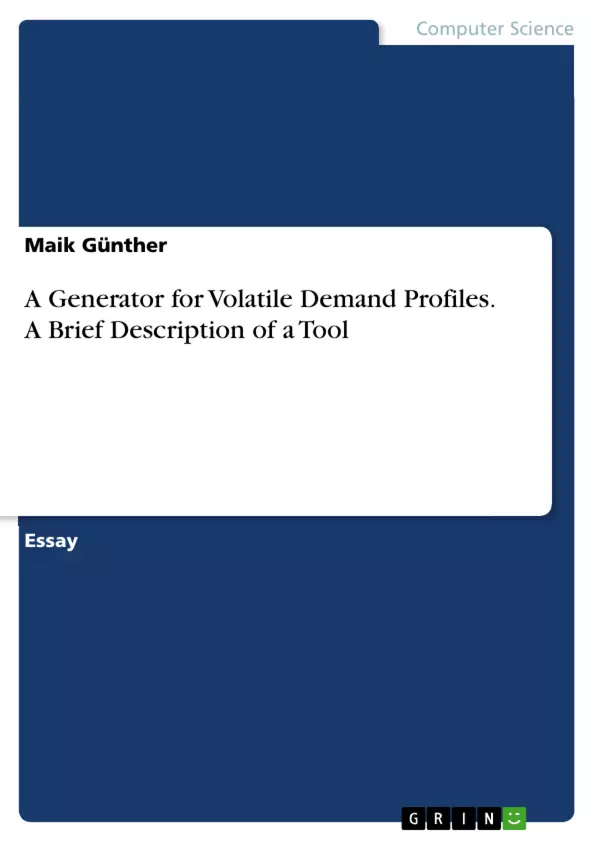To test, compare and improve algorithms and new approaches for staff scheduling, planning problems are needed. Such problems are often not available in literature. Therefore, the Demand Generator was developed to create own problems for staff scheduling. The actual parameters of this tool are based on real data of a call center, which were only slightly modified for the purpose of data protection of the call center. Nevertheless, the tool can also be used for other industries like retail sector or logistics.
The described tool creates for a whole year in hourly resolution values for the staffing demand of a specific workstation or a specific function. Opening hours, holidays, weekdays, min/max staffing levels, stochastic elements, events and weather effects are taken into account by the Demand Generator.
Inhaltsverzeichnis (Table of Contents)
- 1 Introduction
- 1 Function of the Demand Generator
- 1.1 Deterministic Core
- 1.2 Weekday Factors
- 1.3 Events
- 1.4 Ornstein-Uhlenbeck Process
- 1.5 Min/Max Levels
Zielsetzung und Themenschwerpunkte (Objectives and Key Themes)
The objective of this working paper is to present the Demand Generator, a tool designed to create volatile demand profiles for staff scheduling problems. These profiles are useful for testing and improving algorithms and approaches in staff scheduling, as such data is often unavailable in existing literature. The tool is based on real-world call center data, but is adaptable to other industries.
- Generation of volatile demand profiles for staff scheduling.
- Use of real-world data (modified for data protection).
- Adaptability to various industries (call centers, retail, logistics).
- Incorporation of stochastic elements and external factors.
- Public availability and modification of the tool.
Zusammenfassung der Kapitel (Chapter Summaries)
1 Introduction: This introductory chapter establishes the need for the Demand Generator due to the scarcity of suitable real-world data for testing staff scheduling algorithms. It highlights that the generator uses slightly modified data from a call center, but its applicability extends to other sectors like retail and logistics. The tool produces hourly demand values for an entire year, considering factors such as opening hours, holidays, weekdays, staffing levels, stochasticity, events, and weather effects. An example illustrating the weekly demand output is provided.
1 Function of the Demand Generator: This chapter details the functionality of the Demand Generator, built using MS Excel and Visual Basic. It outlines the five steps involved in generating the demand profile: (1) defining a deterministic core demand; (2) incorporating weekday factors to adjust the core demand based on day-of-week variations; (3) integrating user-defined events that influence demand on specific days (e.g., holidays, marketing campaigns); (4) adding stochasticity using an Ornstein-Uhlenbeck process; and (5) imposing minimum and maximum demand limits. The chapter explains each step with illustrative figures and emphasizes the user's ability to activate or deactivate individual steps. The final output is presented in two tables: one organized by week and hour, and another by day and hour.
Schlüsselwörter (Keywords)
Staff scheduling, demand generation, volatile demand profiles, algorithm testing, stochastic processes, Ornstein-Uhlenbeck process, call center data, MS Excel, Visual Basic, data simulation, personnel planning.
Demand Generator: Frequently Asked Questions
What is the purpose of this working paper?
This working paper introduces the Demand Generator, a tool designed to create volatile demand profiles for staff scheduling problems. The tool addresses the lack of suitable real-world data often found in existing literature, allowing for more robust testing and improvement of staff scheduling algorithms.
What kind of data does the Demand Generator produce?
The Demand Generator produces hourly demand values for an entire year. These profiles incorporate various factors influencing demand, including opening hours, holidays, weekdays, staffing levels, stochasticity, events, and even weather effects (although the specific inclusion of weather effects isn't explicitly detailed).
What are the key features of the Demand Generator?
Key features include the generation of volatile demand profiles, the use of (modified) real-world call center data, adaptability to various industries (call centers, retail, logistics), incorporation of stochastic elements and external factors, and public availability (allowing modification of the tool).
How does the Demand Generator work? What are the steps involved?
The Demand Generator uses a five-step process: (1) defining a deterministic core demand; (2) incorporating weekday factors; (3) integrating user-defined events; (4) adding stochasticity via an Ornstein-Uhlenbeck process; and (5) imposing minimum and maximum demand limits. Each step can be activated or deactivated by the user.
What software is used to build the Demand Generator?
The Demand Generator is built using MS Excel and Visual Basic.
What are the outputs of the Demand Generator?
The final output is presented in two tables: one organized by week and hour, and another by day and hour.
What is the significance of using the Ornstein-Uhlenbeck process?
The Ornstein-Uhlenbeck process is used to add stochasticity (randomness) to the demand profiles, making them more realistic and representative of real-world fluctuations.
For which industries is the Demand Generator applicable?
While based on call center data, the Demand Generator is adaptable to various industries, including retail and logistics.
Where can I find more information on the specific details of each chapter?
The document provides chapter summaries outlining the key content of the Introduction and the chapter detailing the function of the Demand Generator. The full tool and its functionality would need to be examined for complete detail.
What are the keywords associated with this working paper and the Demand Generator?
Keywords include: Staff scheduling, demand generation, volatile demand profiles, algorithm testing, stochastic processes, Ornstein-Uhlenbeck process, call center data, MS Excel, Visual Basic, data simulation, personnel planning.
- Arbeit zitieren
- Dr. Maik Günther (Autor:in), 2017, A Generator for Volatile Demand Profiles. A Brief Description of a Tool, München, GRIN Verlag, https://www.grin.com/document/373555



